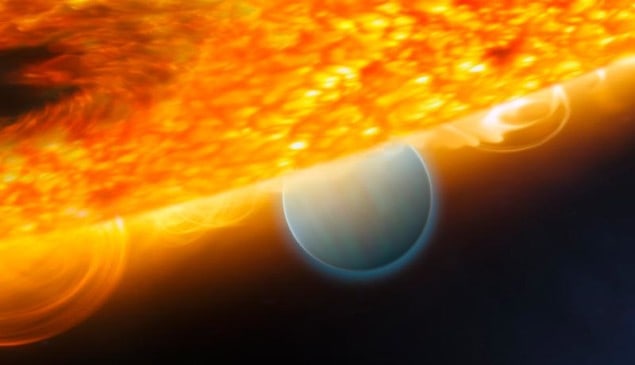
Researchers in the US, UK and Germany have used a ground-based telescope to detect organic compounds in the atmosphere of an exoplanet – that is, a planet orbiting a star other than our Sun. The result, the researchers claim, will open up the hunt for Earth-like planets to anyone with access to a decent telescope. “We expect a massive explosion of exoplanet research because it is not limited anymore to the lucky few who have access to space telescopes,” says Pieter Deroo at the California Institute of Technology.
Since astronomers made the first discovery of a planet orbiting another star in 1992 they have gone on to catalogue more than 400 of these exoplanets. The favoured hunting technique is known as the transit method whereby astronomers monitor the light from a star and look for dips in its intensity caused by a planet sweeping in front of its parent star cutting across the line of vision from Earth.
Honing in on exoplanets
The next stage in exoplanet research is to start looking a bit more closely at the nature of these planets with the ultimate goal of discovering a planet with habitable conditions like Earth’s. The first step is to decipher the chemical composition of exoplanetary atmospheres as this could provide information about a planet’s formation and evolution; it might also reveal the signatures of life.
To date, the most popular approach has been to adapt the transit detection method to study how starlight, observed from Earth, is affected during eclipses. The idea is a relatively simple one: compare the spectrographic data of a star’s light when an exoplanet is first in front then behind its parent star in relation to our line of vision.
This exoplanetary eclipse technique is proving successful with the detection of water vapour, carbon dioxide and carbon monoxide in the atmospheres of the hot-Jupiter type exoplanets HD 189733b and HD 209458b. So far, however, these discoveries have only been possible using data from telescopes located beyond the Earth’s swirling atmosphere, which tends to distort our view.
View from Hawaii
Now Deroo and his colleagues have brought the eclipse technique down to Earth. They used NASA’s 3 m Infrared Telescope Facility (IRTF), located atop Mauna Kea in Hawaii, to study the light emitted by the well observed star system HD 189733. By looking for infrared light – the part of the spectrum not currently monitored by space-based planet hunters – the researchers used a new iterative technique for removing atmospheric distortions.
The resulting spectrum is in strong agreement with those acquired using space-based telescopes confirming the presence of water vapour, carbon dioxide and carbon monoxide. What is more, the researchers detect the presence of methane by observing a fluorescent emission, they suggest, by the planet’s close proximity to its parent star – one-tenth of the distance between Mercury and the Sun.
Deroo says that the real beauty of his technique is that it is not limited to detecting large Jupiter-like planets such as this one. “The NASA space mission Kepler will find true Earth-analogues – the new technique will give us a great tool to characterize these planets.”
This research is published in Nature.



